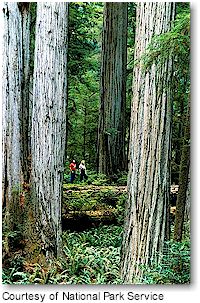|
 Redwood National and State Parks are home to some of the world's tallest trees: old-growth coast redwoods.
Imagine a 35-story skyscraper in your city and you begin to
understand the size of these trees. Redwood National and State Parks are home to some of the world's tallest trees: old-growth coast redwoods.
Imagine a 35-story skyscraper in your city and you begin to
understand the size of these trees.
Redwoods can live to be
2,000 years old and grow to over 300 feet tall. Spruce, hemlock, Douglas-fir, berry bushes, and sword ferns create a multiple canopied understory that towers over all visitors. The parks' mosaic of habitats include prairie/oak woodlands, mighty rivers and streams, and 37 miles of pristine Pacific coastline. Cultural landscapes reflect American Indian history. The more recent logging history has led to much restoration of these parks.
The ancient coast redwood ecosystem preserved in the parks contains some of the planet's most majestic forests. Here, banana slugs, gray whales, Douglas-fir, black bears, and sea anemones are equally at home with redwoods.
Three California state parks and the National Park Service unit represent a cooperative management effort of the National Park Service and California Department of Parks and
Recreation. They are Prairie Creek Redwoods State
Park, Del Norte Coast Redwoods State
Park, Jedediah Smith Redwoods State
Park, and Redwood National Park, comprising 45 percent of all the old-growth redwood forest remaining in California.
Together these parks are a World Heritage Site and International Biosphere Reserve, protecting resources cherished by citizens of many nations.
Getting There:
Redwood National and State Parks are along US Highways 101 and 199. From 101, access additional park sites via the Bald Hills Road, Davison Road, Newton B. Drury Scenic Parkway, Coastal Drive, Requa Road, and Enderts Beach Road (south to north). From 199, take South Fork Road to Howland Hill Road.
|



